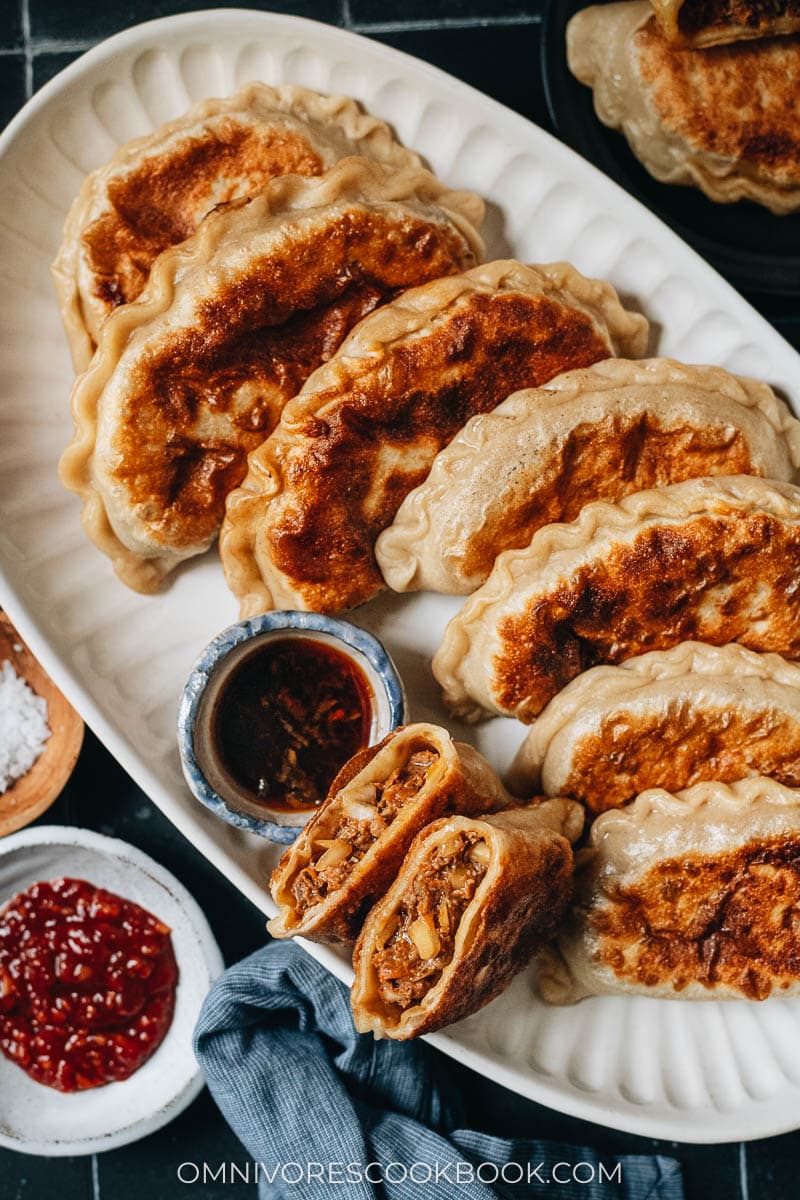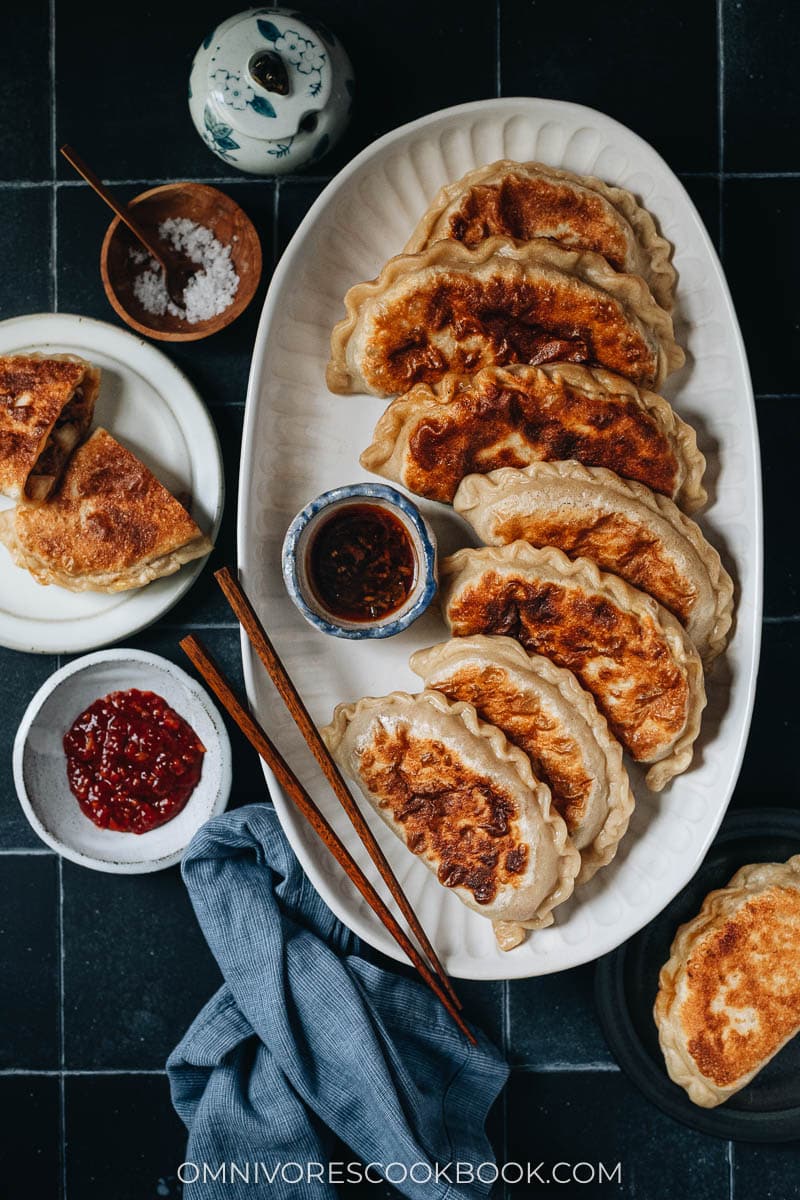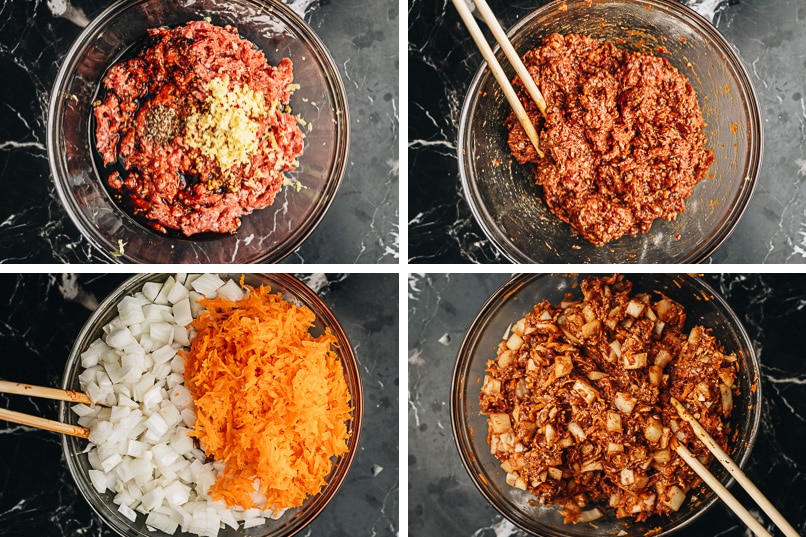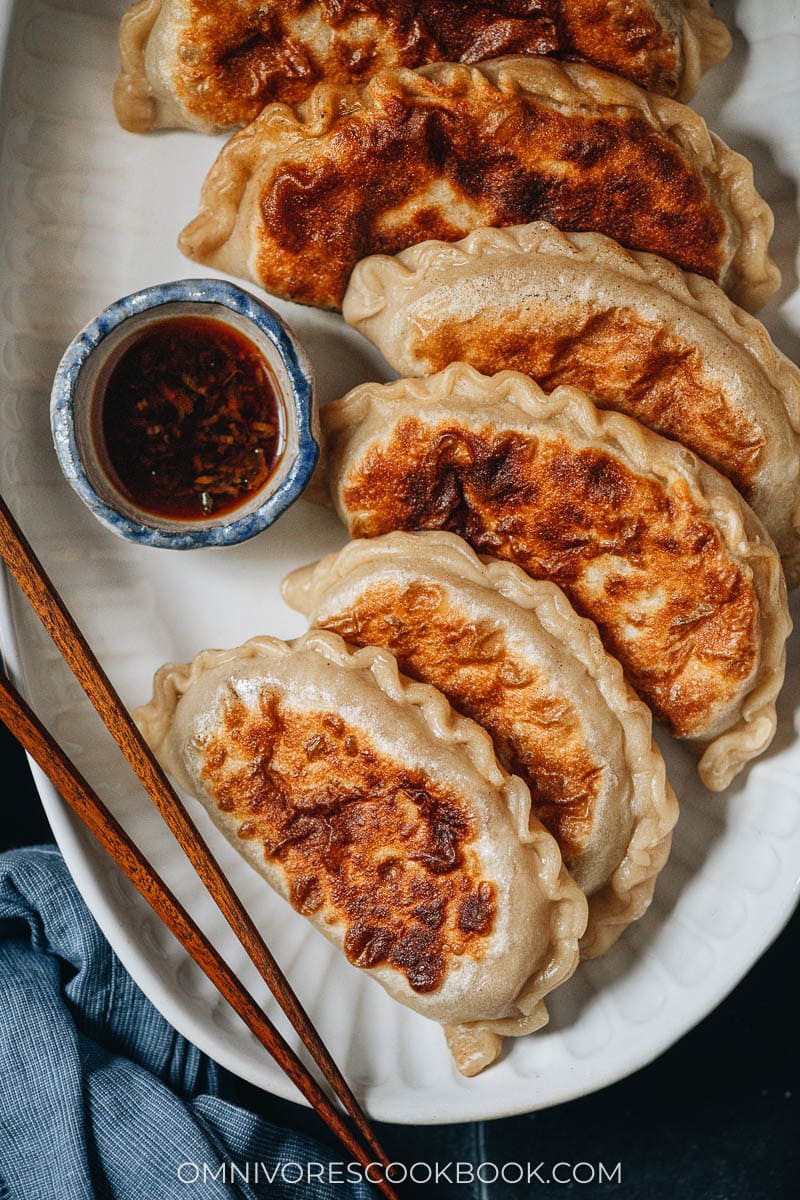
Chinese meat pie (馅饼, Xian Bing), sometimes called meat pocket or big dumpling, is a very popular and tasty comfort food in the northern part of China. The idea is similar to that of the potsticker, but you use a larger piece of dough to wrap in more filling. It has a super crispy crust and a juicy filling, like a giant dumpling.
While Xian Bing is a cheap street food in China, you can easily find it in restaurants, too. It’s typically listed with the staple foods, which include dumplings and rice. I was quite surprised that dumplings have become so popular outside of China, but not Xian Bing. To a Chinese northerner, Xian Bing is as great as dumplings, and much more common than potstickers. Especially when cooking at home, Xian Bing is slightly easier to make because you only need to make a couple of them to feed a family, with leftovers, too.
I like Xian Bing most of all, because it has a layered crispy surface, like pastry dough, with a meaty filling that is more substantial than in potstickers.


Xiang Bing Filling
There are countless ways to make a great Xiang Bing Filling, but some of the most popular ones are beef, pork, and chive and egg. To make the beef filling:
- Mix the ground beef with aromatics and spices.
- Since ground beef is usually quite dry in texture, I prefer to add 2 tablespoons of water to mix into the meat, to create a juicier result.
- Add the vegetables and mix again. I would do this if I plan to wrap the Xiang Bing as soon as the dough is ready. If you plan to use the filling later in the day or the next day, store the vegetables and the meat separately in the refrigerator.
- Add the salt and sesame oil. Mix again. Salt is usually added at the end, because it extracts water from the veggies if added too early. The final ingredient is sesame oil and it wraps around the ingredients to seal the moisture in.

To make the juiciest Xiang Bing, make sure you use a ground beef that’s slightly fattier, and not the super lean type.
Xiang Bing Dough
The crucial part of making a tasty meat pie is the dough. Unlike potstickers and dumplings, it uses a layered oily dough to create a super crispy surface that also holds up the filling. The process is a bit similar to making scallion pancakes.
- Roll the dough into a large thin sheet, brush it with oil and sprinkle with flour
- Roll up the dough into a long stick
- Cut the dough into 6 pieces, so each of them looks like a cinnamon roll
- Use your hands to smooth the dough to cover the cut-sides
- Pinch the dough together to seal the oil inside
- Roll out the dough into a large round wrapper and place the meat filling on one side
- Cover the meat filling with the other side of the dough and press the dough edges together
- Use your fingers to crimp the dough to create a wavy look (see my video below for the process)

The process might look a bit daunting, but trust me, it is actually very easy and straightforward once you try it out. I personally like to serve meat pies instead of dumplings. They are larger in size, which means you will roll less dough and wrap fewer times than you would if you were making dumplings.
There are several ways to fold a meat pie. The recipe below uses the simplest, no-fail way, which will result in a pie with an even thin, crispy crust and lots of filling. The wrapping process is like making a quesadilla, but you take it one step further and press the edges of the dough together to seal the pie.
Cooking xian bing
The cooking method is similar to that used for potstickers, too – using a soft piece of dough to wrap raw filling and grilling it in a frying pan.

The key is to use a hot pan with low heat, so the surface will crisp nicely while cooking through the filling, without burning the dough.
How to serve Xian Bing
Xiang Bing is best served hot, when they’ve just come off the stove. Luckily, they hold up well (thanks to the layered dough) and will stay very crispy after reheating. The filling is well seasoned and can be served by itself. However I do like to serve it with some Chinkiang vinegar or a gingery dipping sauce (see the ginger soy sauce from this recipe). You can also use chili oil or a bit of hot sauce to spice it up.
In China, Xiang Bing is a staple that we eat at any time of day. In the morning, we might grab one from a breakfast vendor on the way to work. My mom likes to serve it with millet congee and cucumber salad for a full dinner. You can easily heat up one for lunch or a snack.
If you like Chinese dumplings, I recommend you try making Xian Bing once. You will definitely love it!

Dishes that go well with Xian Bing
- Plain Congee
- Millet Congee
- Tiger Salad (老虎菜)
- Cucumber Salad
- 4-Ingredient Baby Bok Choy Stir Fry
- Chinese Egg Drop Soup
- Chinese Pickled Cabbage (A Quick Pickle Recipe)
Chinese Cooking Made Easy
Are you new to this website? This free email series is a great place to start. I’ll walk you through a few of my most popular recipes and show you how and why they work. You’ll quickly start to cook better Chinese food in your own kitchen.
Watch video

Chinese Beef Meat Pie (Xian Bing, 牛肉馅饼)
Ingredients
Dough
- 450 g (about 3 cups) all-purpose flour , plus extra to coat hands
- Pinch of salt
- 3/4 cup hot water
- 1/2 cup cold water
Filling
- 12 oz ground raw beef (lean fat ratio 8:2)
- 1 tablespoon minced ginger
- 1 tablespoon Shaoxing wine (or dry sherry)
- 1 tablespoon light soy sauce
- 2 teaspoons dark soy sauce
- 1/4 teaspoon freshly ground Sichuan peppercorn (or black pepper)
- 1 onion , minced
- 1 large carrot , grated
- 1 teaspoon sugar
- 1 1/4 teaspoons salt
- 1 tablespoon toasted sesame oil
Assemble & Cooking
- 1 tablespoon vegetable oil plus extra for cooking
Instructions
- Combine flour and a pinch of salt in a big bowl (or the bowl of a mixer if using) and stir to mix well. Slowly pour hot water onto the dried flour and use a pair of chopsticks to stir until the water is fully incorporated. Then slowly add the cold water onto the dry flour, and keep mixing, until the water is fully incorporated and it forms small dough pieces with no or little dry flour left.
- (Option 1) Using a mixer: Attach the dough hook and turn to medium speed (speed 4). Mix until a smooth and spring dough has formed, 8 minutes.
- (Option 2) Knead the dough by hand: Use your hand to gather and press the dough flakes together to form a dough. If there is too much dry flour in the bowl and it is difficult to blend into the dough, add a bit more water to the dry flour, 1 teaspoon at a time. Knead until there is no dry flour left. The dough should feel soft but you should be able to easily pick it up without it sticking to your hands and the bowl too much. If the dough is too soft, you can sprinkle it with more flour. Transfer the dough onto a clean working surface and keep kneading, until the dough turns smooth and springy, 10 to 15 minutes.
- Transfer the dough to a medium-sized bowl. Seal the bowl with plastic wrap. Let rest for at least 1 hour, or up to 3 hours. The longer you rest the dough, the easier it will be to work with later. If you plan to store the dough overnight, store the covered bowl in the refrigerator.
To make the filling
- Prepare the filling while resting the dough. Combine ground beef, minced ginger, Shaoxing wine, light soy sauce, dark soy sauce, and ground Sichuan peppercorn (or black pepper) in a big bowl. Mix well until the liquid ingredients are fully absorbed and the meat has turned into a sticky paste. If the paste feels very dry and is hard to mix, add 2 tablespoons of water and mix again until the water is fully incorporated. (*Footnote 1)
- Prepare and cut the vegetables, but do not add them to the ground beef yet.
- Right before assembling the pies, add the onion, carrot, salt and sugar to the beef filling. Mix well. Add sesame oil and mix again. (*Footnote 2)
To assemble the pies
- Add 1 tablespoon of oil into a small bowl. Prepare a small brush. And some extra flour on the side.
- Transfer the dough onto a clean working surface. The dough should now have turned a bit softer and smoother.
- Divide the dough into two equal pieces and put one piece back in the bowl and cover it with plastic wrap. Roll the other half into a ball. Press it slightly so it’s easier to roll out. Use a rolling pin to roll it into a thin round disc, about 1/8” (3 mm) thick, 12” (30 cm) long and 10” (25 cm) wide.
- Brush a very thin layer of oil on top. Sprinkle about 1/2 tablespoon of flour evenly over the dough and brush it again until evenly spread. Roll the round dough sheet from the bottom into a long stick. Cut the stick into 6 equal pieces.
- Work on the meat pies one at a time. Cover the rest of the dough with plastic wrap.
- Pinch the two ends of each piece of the roll to seal the oil inside. Place the dough on the working surface, with the two pinched ends pointing on the sides. Press the dough gently and form it into a round shape. Roll the dough until it forms a thin round disc, about 1/8” (3 mm) thick and 7” (18 cm) in diameter. This step helps to create a layered crust.
- Scoop 2 to 3 tablespoons of beef filling and place it on one side of the disc, in a half-moon shape.
- Fold the empty half over and press the edges together by hand. Turn the edge upward and press it again to further seal the pie.
- Set the pie aside on a large tray or plate, brush a thin layer of oil on top, cover with plastic wrap, and work on the rest of the dough in the same manner.
To cook the pies
- Heat a large nonstick skillet with 2 tablespoons of oil over medium heat until hot, but not smoking hot. Transfer meat pies to the skillet without overlapping and press down with a spatula gently, to flatten the bottom for maximum crispy crust. Cover the skillet and cook over low heat until the bottom side turns golden brown, 3 minutes or so. Uncover and check the meat pie after 2 minutes, to make sure it’s not browning too fast. Once browned, flip with a spatula and cook the other side. Cover and cook until the bottom side turns golden brown, 3 minutes. Then you can flip the meat pie again if you wish to brown any sides a bit longer. Cook without cover for another minute or so until both sides are golden brown. Transfer the meat pies to a larger plate. Cook the remainder of the meat pies the same way.
- Serve hot with Chinese black vinegar. If the meat pie is not salty enough, blend 1 teaspoon light soy sauce with 1 tablespoon black vinegar as a dipping sauce.
To store the meat pie
- Place meat pie in an airtight container. Store in the fridge for up to 3 days or in the freezer for 3 months.
- To reheat the meat pie. Heat oil in a skillet over medium heat until warm. Add meat pies and turn to low heat. When the skillet is hot, add 2 to 3 tablespoons of water and cover immediately. Flip once during the cooking. Cook until both sides are crispy and the inside is hot, 3 to 4 minutes. You can cook the frozen meat pies the same way, but you will need another 8 minutes to cook through the inside. You can also heat up the frozen cooked meat pies in a preheated oven, around 350°F (176°C) until crispy and warmed through, 15 minutes or so.
Notes
- The meat filling will feel dry if you use very lean ground beef. Adding water to the filling will help yield a juicier result.
- If you add the vegetables and salt too early, the salt will extract liquid from the meat and the vegetables. The filling will end up watery and hard to work with when you assemble the pies.
Nutrition

Did you make this recipe?
I’d love to hear how it turned out for you! Please take a moment to leave a 5-star rating ⭐️ and share your thoughts in the comments further down the page. It really helps others discover the recipe too.
The post was published Oct. 1, 2015 and was updated Apr. 26, 2022 with new pictures and video.

Christine
If I want to make this ahead of time, do I freeze them cooked, or uncooked?
Christine
If I wanted to make these ahead of time, would I freeze then before they’re cooked, or after?
Maggie Zhu
I think you can freeze them before cooking. The dough is layered and is quite resilient. I would thaw it in the fridge overnight before cooking.
R
I had hoped to multiply the recipe, but the calculator didn’t work! It doubled some things but not others so the dough was very wet until I checked the original recipe. FYI.
Maggie Zhu
Sorry about that! This is a recipe format issue and I just fixed it.
Reni
Very tasty! I had some trouble with the juices seeping out of my wrapped, uncooked xian bing (they kept opening, but I had messed with the recipe so it’s me who must’ve messed up somewhere.) Regardless, they turned out delicious! Next time I’ll fix my juice problem. Also, maybe I’ll bake the delicious, soft red bean bread on a separate day 😉
Paulette
Very nice! The dough was almost fun to work with it was so nice. I was also pleasantly surprised how juicy they were! 2 thumbs up!
Melissa
I loved the recipe, I had to change me meat to ground chicken. So delicious! I’m tired after all the dough rolling though lol. So worth it! Thanks
Brent
Lovely but how is this Asian? More like a classic English meat pie would you say
Maggie Zhu
It is a very classic Northern Chinese dish that I ate growing up. I’m not super familiar with English meat pie, but I think their ingredients are cooking methods are different.
This one uses a dumpling dough and it’s pan fried, so the crust is chewy, like fried dumplings (I believe English meat pie uses pastry dough and it’s baked).
The seasoning has ingredients like ginger, sesame oil and Sichuan peppercorns, making it very savory with distinctive fragrance.
林秉恩
made this for the 3rd time yesterday, it has never disappointed once 🙂 delicious and delightful!
Maggie Zhu
So happy to hear you made this and enjoyed it! Thanks for leaving a positive review 🙂
Jennifer
Odd question.
Could you make these using frozen then thawed Scallion Pancakes?
Maggie Zhu
I suppose you could! It’s essentially the same type of dough (without the scallion). Maybe you can scale down the recipe and try 1 or 2 at a time. Pretty much you can roll out the thawed scallion pancake, put the filling on one side, then fold it up, cook according to this recipe. I think it should be tasty!
Jennifer
I think it would be tasty too!
And it opens up thoughts about using the scallion pancake with other fillings as well! Thanks for the inspiration!
amy
what can i do with a ton of leftover dough?
Maggie Zhu
You can freeze or refrigerate them to use later. It’s a dough that’s similar to scallion pancakes. So you can make it if you wish: https://omnivorescookbook.com/chinese-scallion-pancakes/ (you pretty much just need to do the filling. And if the dough is relaxed enough in the fridge, it’s easy to roll out)
Penny
I made these this evening. Actually I made some ’round’ ones yesterday and was looking for a way to not have the lump of glutinous dough that I got when sealing. ‘Pasties’ I thought, and lo and behold there was your version! I liked it and, it is more flavoursome and, stays crispy. I did run out of filling (given I was using stuff up) and experimented with cheese, mushroom and a little harissa: they were a hit too 🙂
Maggie Zhu
So happy to hear you tried out this one! Yes, I prefer this folding much better because the wrapper will be thin throughout and you can stuff a ton of filling 🙂 Thanks for leaving a positive review!